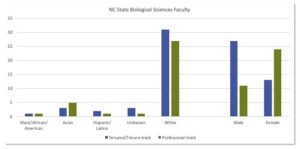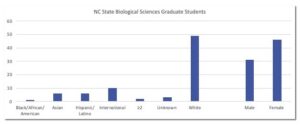BEIA FAQ
Who is on the Building Equity through Inclusion and Access (BEIA) Committee?
This committee is comprised of students, staff, and faculty within the Biological Sciences department. If you are interested in joining – please contact Dr. Claire Gordy (clgordy@ncsu.edu)
What is the history of the BEIA committee?
In Spring 2017, the BioSci faculty and staff came together to create the Department’s first Strategic Plan. Committees were formed to develop different aspects of the plan and a draft document was shared in July 2017. The committee charged with addressing diversity and inclusion continued to meet thereafter and grew organically as additional faculty and staff volunteered. In 2020, the committee joined forces with the Howard Hughes Medical Institute (HHMI) Inclusive Excellence Grant team in order to share resources and work together toward common goals. An open invitation was issued (and remains in place) to faculty and staff in summer 2020 to participate in the committee. The committee began reporting out at faculty, staff and department meetings beginning in August 2020. A website was developed (with this FAQ page) and launched in fall 2020 to further ensure transparency of committee activities and respond to questions as they were raised. The committee name was changed to JEDI (Justice, Equity, Diversity, and Inclusion) in April 2021 to resolve the inconsistent use of DI vs. DEI, and changed again in March 2023 to BEIA (Building Equity through Inclusion and Access) to reflect the committee’s focus on ongoing work to build equity for students, faculty, and staff, and to reflect our work toward increasing educational access.
What are equity, diversity and inclusion?
- Equity is promoting justice, impartiality and fairness within the procedures, processes, and distribution of resources by institutions or systems. Tackling equity issues requires an understanding of the root causes of outcome disparities within our society.
- Diversity is the presence of differences that may include race, gender, religion, sexual orientation, ethnicity, nationality, socioeconomic status, language, (dis)ability, age, religious commitment, or political perspective. Populations that have been-and remain- underrepresented among practitioners in the field and marginalized in the broader society.
- Inclusion is an outcome to ensure those that are diverse actually feel and/or are welcomed. Inclusion outcomes are met when you, your institution, and your program are truly inviting to all. To the degree to which diverse individuals are able to participate fully in the decision-making processes and development opportunities within an organization or group.
How are equity, diversity and inclusion related?
Working toward diversity without working toward equity and inclusion is unjust. Attempting to increase the numbers of individuals from marginalized and minoritized backgrounds and identities in an organization without addressing systemic barriers and sources of oppression that exist in the organization directly harms these individuals. The higher education system in the US was built on systems of oppression. It was built to exclude, to educate certain groups of people and to further concentrate wealth, power, and resources. Many of the overtly exclusive policies no longer stand — colleges and universities are no longer legally segregated — but that doesn’t mean that oppressive structures aren’t still part of the higher education system, part of predominantly-White institutions such as NC State, and part of our department. Thus, we cannot focus solely on increasing recruitment or representation of individuals from underrepresented groups.
Why do we need this committee?
We recognize that there is insufficient diversity among our faculty and students. In the spririt of transparency, we provide data from NC State’s Office of Institutional Research and Planning (OIRP; diversity numbers are not provided for staff). We are committed to increasing our diversity in all parts of our community through development of more intentional recruitment and rentention.



What are we doing as a department to promote BEIA?
See some of the actions we are taking to promote BEIA in Biological Sciences and beyond.
Where can I find out about continuing education opportunities on BEIA?
The following are recommended trainings available through campus entities (see also, our evolving Resources page):
- Inclusive Excellence in the Life Sciences (HHMI)
- GLBT Center
- Office for Institutional Equity and Diversity (OIED)
- Green Zone Training